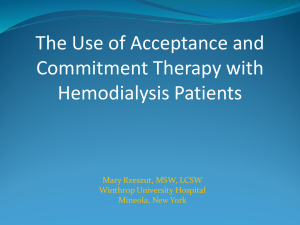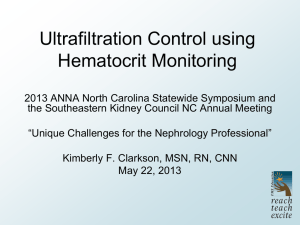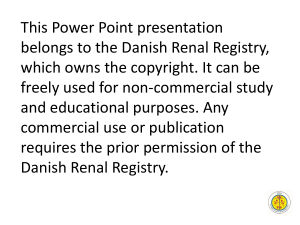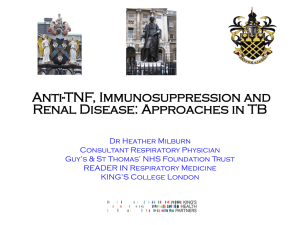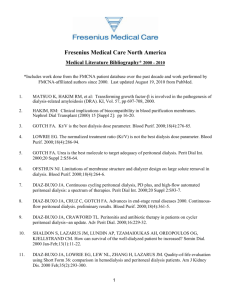Dyslipidemia in hemodialysis patients
advertisement
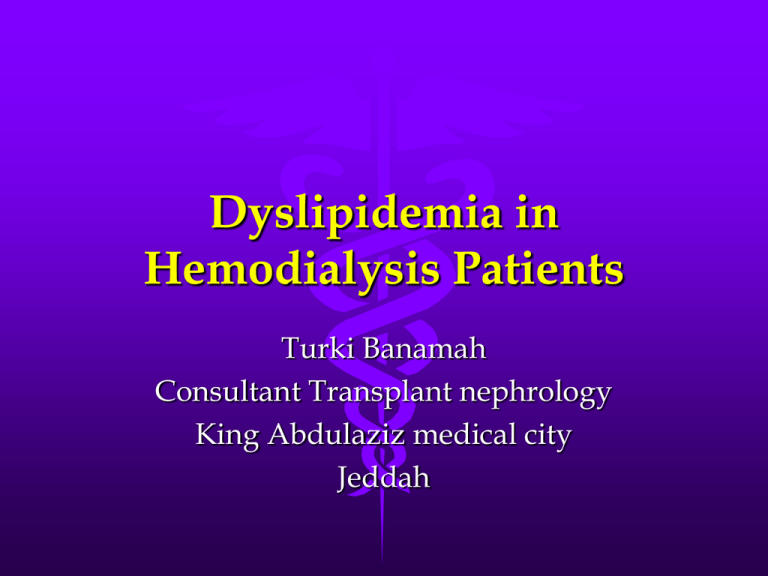
Dyslipidemia in Hemodialysis Patients Turki Banamah Consultant Transplant nephrology King Abdulaziz medical city Jeddah Objectives • Definition of dyslipidemia in Hemodialysis Patient. • Normal Structure and Function of Lipoproteins. • Pathophysiology of Dyslipidemia in CKD and Dialysis. • Is Lipid Control Necessary in Hemodialysis Patients? • Analyze the recent clinical trial • Conclusion • Dyslipidemia is an established cardiovascular (CV) risk factor in the general population. • In chronic kidney disease (CKD), however, epidemiologic studies and clinical trials have raised uncertainties regarding the impact of dyslipidemia on clinical outcomes and, consequently, the optimal lipid profile. J Am Soc Nephrol 18: 1246–1261, 2007. doi: 10.1681/ASN.2006091006 • Dyslipidemia is empirically defined as plasma lipid and lipoproteins that are associated with adverse outcomes such as CV disease (CVD) in the general population. • Whether this definition is justified in patients with CKD requires further investigations. J Am Soc Nephrol 18: 1246–1261, 2007. doi: 10.1681/ASN.2006091006 Normal Structure and Function of Lipoproteins • Lipoproteins consist of lipids and proteins (known as apolipoproteins [apo]), with the main function of transporting waterinsoluble lipids such as cholesterol or triglycerides in plasma from the sites of absorption (gut) and/or synthesis (liver) to the sites of utilization (peripheral tissues) or processing. J Am Soc Nephrol 18: 1246–1261, 2007. doi: 10.1681/ASN.2006091006 • Besides contributing to the structure and the stability of the macromolecule, Apo lipoproteins control the metabolism of the lipoproteins by activation or inhibition of enzymes and interaction with lipoprotein receptors. J Am Soc Nephrol 18: 1246–1261, 2007. doi: 10.1681/ASN.2006091006 Pathophysiology of Dyslipidemia in CKD and Dialysis • The spectrum of dyslipidemia in patients with CKD and dialysis patients is distinct from that of the general population. • It involves all lipoprotein classes and shows considerable variations depending on the stage of CKD. J Am Soc Nephrol 18: 1246–1261, 2007. doi: 10.1681/ASN.2006091006 • There seems to be a gradual shift to the uremic lipid profile as kidney function deteriorates. • Apart from quantitative differences, major qualitative changes in lipoproteins can be observed, such as oxidization and modification to sdLDL, which render the particles more atherogenic. J Am Soc Nephrol 18: 1246–1261, 2007. doi: 10.1681/ASN.2006091006 Hypertriglyceridemia • Plasma triglycerides are predominantly found in two types of lipoproteins in normal individuals. • These are chylomicrons, which are assembled in the intestine for the transport of dietary fatty acids, and VLDL, which are produced in the liver for the transport of endogenous fatty acids. J Am Soc Nephrol 18: 1246–1261, 2007. doi: 10.1681/ASN.2006091006 • The accumulation of triglycerides is the consequence of both a high production rate and a low fractional catabolic rate . • The reduced fractional catabolic rate is likely due to the decreased activity of two endothelium-associated lipases, namely, LPL and hepatic triglyceride lipase, which have the primary physiologic function of cleaving triglycerides into FFA for energy production or storage. J Am Soc Nephrol 18: 1246–1261, 2007. doi: 10.1681/ASN.2006091006 • The cause of the decreased lipase activities in uremia is thought to be depletion of the enzyme pool induced by frequent heparinization in hemodialysis (HD) patients • An increase in the plasma apoC-III/apoC-II ratio, and the presence of other lipase inhibitors in plasma. • ApoC-II is an activator of LPL, whereas apoC-III is an inhibitor of LPL. J Am Soc Nephrol 18: 1246–1261, 2007. doi: 10.1681/ASN.2006091006 • The increased apoC-III/apoC-II ratio is usually due to a disproportionate increase in plasma apoC-III . • The impaired lipase activities in uremic plasma may also be caused by a decrease in LPL synthesis as a result of secondary hyperparathyroidism or suppressed insulin level . J Am Soc Nephrol 18: 1246–1261, 2007. doi: 10.1681/ASN.2006091006 High-Density Lipoprotein • Patients with CKD generally have reduced plasma HDL cholesterol concentrations compared with nonuremic individuals Because of the low apo-AI level and decreased LCAT activity , the esterification of free cholesterol and hence the conversion of HDL3 to HDL2 are diminished in uremia. J Am Soc Nephrol 18: 1246–1261, 2007. doi: 10.1681/ASN.2006091006 • In summary, the hallmarks of uremic dyslipidemia are hypertriglyceridemia; increased remnant lipoproteins (chylomicron remnants and IDL); reduced HDL cholesterol; and in-creased sdLDL, Lp(a), and apoA-IV. • Elevated plasma LDL cholesterol level is not typical but can mostly be observed in patients with Nephrotic syndrome and PD patients. J Am Soc Nephrol 18: 1246–1261, 2007. doi: 10.1681/ASN.2006091006 • Is Lipid Control Necessary in Hemodialysis Patients? Clin J Am Soc Nephrol 4: S95–S101, 2009. doi: 10.2215/CJN.04780709 Observational Studies of Hypercholesterolemia in the Dialysis Population • Chronic kidney disease (CKD) represents a very wide spectrum of GFRs and proteinuria, associated with highly variable rates and risk factors for cardiovascular events. • The coronary risk factors for individuals with stage 1 or 2 CKD are generally quite similar to those without kidney disease . Clin J Am Soc Nephrol 4: S95–S101, 2009. doi: 10.2215/CJN.04780709 • In contrast, a number of epidemiologic studies and a few randomized clinical trials have shown unconventional associations of cardiovascular risk factors with clinical outcomes in long-term dialysis patients. • The first large observational study relating serum cholesterol levels and clinical outcomes was published in the early 1990s, based on the database of National Medical . Lowrie EG, Lew NL: Death risk in hemodialysis patients: The predictive value of commonly measured variables and an evaluation of death rate differences between facilities. Am J Kidney Dis 15: 458–482, 1990 • In that study, a U-shape relationship between serum total cholesterol level and the risk for all-cause mortality was observed, with the lowest risk found in the category with cholesterol levels between 200 and 250 mg/dl. • Cholesterol levels between 250 and 300 mg/dl seemed to be associated with a modest increase in mortality risk, but the subgroup with cholesterol levels 100 mg/dl had a threefold increase in mortality risk after adjustment for case mix. Lowrie EG, Lew NL: Death risk in hemodialysis patients: The predictive value of commonly measured variables and an evaluation of death rate differences between facilities. Am J Kidney Dis 15: 458–482, 1990 • (CHOICE) Study by Liu et al. is compatible with this hypothesis. • In that analysis, 823 incident dialysis patients were classified by the presence or absence of inflammation and/or malnutrition (defined as low serum albumin levels or elevated serum levels of C-reactive protein or IL-6). • An increase in baseline serum cholesterol level was associated with a decreased risk for all-cause mortality in the entire CHOICE cohort. Liu Y, Coresh J, Eustace JA, Longenecker JC, Jaar B, Fink NE, Tracy RP, Powe NR, Klag MJ: Association between cholesterol level and mortality in dialysis patients: Role of inflammation and malnutrition. JAMA 291: 451–459, 2004 • Recent randomized trials Die Deutsche Diabetes Dialyse Studie (4D) targeted German patients who had type 2 diabetes and ESRD and were on long-term hemodialysis • A multicenter, randomized, double-blind, prospective study of 1255 subjects with type 2 diabetes mellitus receiving maintenance hemodialysis who were randomly assigned to receive 20 mg of atorvastatin per day or matching placebo. • The primary end point was a composite of death from cardiac causes, nonfatal myocardial infarction, and stroke. • Secondary end points included death from all causes and all cardiac and cerebrovascular events combined. Die Deutsche Diabetes Dialyse Studie (4D) targeted German patients who had type 2 diabetes and ESRD and were on long-term hemodialysis • There are several potential interpretations of this seemingly negative result. • First, LDL cholesterol may not be important in the pathogenesis of cardiovascular disease in dialysis patients. • Second it could mean that atherosclerosis is not a major cause of cardiovascular death. • The most common causes of cardiac death listed in the US Renal Data System and the Hemodialysis (HEMO) Study were sudden death, arrhythmia, and unknown. Die Deutsche Diabetes Dialyse Studie (4D) targeted German patients who had type 2 diabetes and ESRD and were on long-term hemodialysis • A third potential explanation is that statins are, in fact, effective in decreasing cardiovascular events in dialysis patients with diabetes, but the sample size of the 4D Study was not sufficiently large to detect the modest effect. Die Deutsche Diabetes Dialyse Studie (4D) targeted German patients who had type 2 diabetes and ESRD and were on long-term hemodialysis • A post hoc analysis was conducted of the 4D (Die Deutsche Diabetes Dialyze) study to investigate whether LDL-cholesterol at baseline is predictive of cardiovascular events and whether the effect of atorvastatin on clinical outcomes depends on LDLcholesterol at baseline. • Atorvastatin significantly reduced the rates of adverse outcomes in the highest quartile of LDL-cholesterol (145 mg/dl, 3.76 mmol/L). Die Deutsche Diabetes Dialyse Studie (4D) targeted German patients who had type 2 diabetes and ESRD and were on long-term hemodialysis • In patients with type 2 diabetes mellitus undergoing hemodialysis, atorvastatin significantly reduces the risk of fatal and nonfatal cardiac events and death from any cause if pretreatment LDL-cholesterol is 145 mg/dl (3.76 mmol/L). Die Deutsche Diabetes Dialyse Studie (4D) targeted German patients who had type 2 diabetes and ESRD and were on long-term hemodialysis A study to evaluate the Use of Rosuvastatin in subjects On Regular hemodialysis: an Assessment of survival and cardiovascular events (AURORA) • An international, multicenter, randomized, double-blind, prospective trial involving 2776 patients, 50 to 80 years of age, who were undergoing maintenance hemodialysis. • Randomly assigned patients to receive Rosuvastatin, 10 mg daily, or placebo. • The combined primary end point was death from cardiovascular causes, nonfatal myocardial infarction, or nonfatal stroke. • Secondary end points included death from all causes and individual cardiac and vascular events. A study to evaluate the Use of Rosuvastatin in subjects On Regular hemodialysis: an Assessment of survival and cardiovascular events (AURORA) • The major differences in the study design between AURORA and the 4D Study are as follows: • (1) The AURORA enrolled approximately twice as many patients as the 4D Study. • (2) approximately 74% of the AURORA patients did not have diabetes, whereas the 4D Study targeted patients with diabetes exclusively • (3) the 4D study was more generalizable from the age standpoint; the lower age limit of the 4D study was 18 yr, whereas the lower age limit of AURORA was 50 yr. • Despite these differences, the remarkable similarity between these two trials was the apparent lack of efficacy for statins to decrease cardiovascular events in the longterm hemodialysis population. • A post-hoc analysis of 731 diabetic patients from AURORA also showed no difference in the composite outcome or in the risk of stroke • There was a 32 percent reduction in cardiac events (including cardiac death and nonfatal MI) among diabetic patients assigned to receive rosuvastatin (n = 388) compared with placebo (n = 343) (HR 1.68, 95% CI 0.51-0.90) . • The Study of Heart and Renal Protection (SHARP) trial. • In this study, 9270 patients with CKD with no history of myocardial infarction or coronary revascularization were randomized to simvastatin/ ezetimibe or placebo. • The study included 3023 patients undergoing dialysis at study entry, and 2000 additional patients reached ESRD during the course of the study. • The intervention resulted in a net decrease in LDL cholesterol of 35 mg/dl, and over a median follow-up of 4.9 years, a 17% lower risk for atherosclerotic vascular events (nonfatal myocardial infarction, coronary death, ischemic stroke, arterial revascularization) • There was no reduction in either overall or cardiovascular mortality. • Only one-quarter of all vascular deaths were classified as being secondary to atherosclerosis . Recommendation • In the dialysis population, approximately 60 percent of all cardiac deaths are presumably due to sudden death or arrhythmias. • We agree with the 2013 KDIGO guidelines that suggest that statin therapy be continued in patients who are already receiving statins or a statin/ezetimibe combination at the time of initiation of dialysis. • if statin therapy is administered to dialysis patients, the following goals are reasonable, although they have not been validated in dialysis patients: • A serum LDL-cholesterol of <100 mg/dL (<2.6 mmol/L) • A non-high-density lipoprotein (HDL)cholesterol concentration (ie, total minus HDL-cholesterol) of <130 mg/dL (<3.36 mmol/L) in patients who have already achieved the target LDLcholesterol level, but have fasting triglycerides ≥200 mg/dL (≥2.26 mmol/L). • Diabetic individuals with higher LDL cholesterol may have the greatest benefit with statin therapy (eg, >190 mg/dL [4.9 mmol/L]) • Although some authers suggest to start any diabetic patient on dialysis with high cholestrol on statin . Thanks
